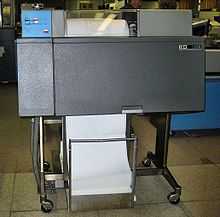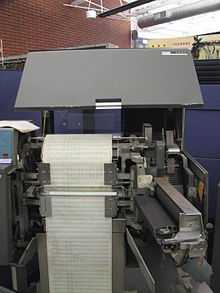IBM 1403

The IBM 1403 line printer was introduced as part of the IBM 1401 computer in 1959 and had an especially long life in the IBM product line. The original model could print 600 lines of text per minute and could skip blank lines at up to 75 inches/second. The standard model had 120 print positions. An additional 12 positions were available as an option. A print chain with at least five copies of the character set spun horizontally in front of the ribbon and paper. Hammers struck the paper from behind at exactly the right moment to print a character as it went by. In later models, the print chain was replaced by a print train; print slugs instead of being mounted on a chain were placed in a track.

The standard 1403 chain or train could print 48 different characters: 26 letters, 10 digits, and 12 special characters: &, . - $ * / % # @ ≠ ⌑. Special chains or trains could be ordered for other character sets. Scientific users, for example, would use a chain that had the left parenthesis, the right parenthesis, and the plus sign in place of the per cent sign (%), the lozenge (⌑),[1] and the ampersand (&). The numerics chain had more copies of fewer characters.
The ink ribbon was a long roll the width of the print area that was positioned between the print chain and the paper. The roll came in two parts, the feeder roll and take-up roll. The roll was constantly wound and rewound during printing.

Like most IBM printers of the era, the 1403 used fan-folded paper with perforated edges for tractor feeding. A carriage control tape or, later, a buffer, under program control,[2] specified form length and the form line where printing was to begin so that paper of various sizes could be used.
An IBM 1403 printer played a cameo role in Stanley Kubrick's 1964 movie Dr. Strangelove, serving as a hiding place for a portable radio.
The overstrike capability of the printer was used to generate a wide range of grey-scale equivalents. Many images were scanned, pixelated and could be reproduced on the 1403, most notably the Mona Lisa.[3][4]
These were noisy machines, especially when the cover was raised. Some people were able to create text that used the timing of the print hammers to generate desired frequencies and actually play music when that text was printed.[5]
Models

The IBM 1403 had the following models:
- Model 1: 100 print positions, maximum of 600 lines per minute, or 1285 with the Numerical Print Special Feature.
- Model 2: 132 print positions, maximum of 600 lines per minute, or 1285 with the Numerical Print Special Feature, or 750 with Universal Character Set.
- Model 3: 132 print positions, maximum of 1100 lines per minute, or 1400 with the Preferred or Universal Character Sets and had a power driven cover that went to the floor to cut noise.
- Model 4: 100 print positions, maximum of 465 lines per minute.
- Model 5: 132 print positions, maximum of 465 lines per minute.
- Model 6: 120 print positions, maximum of 340 lines per minute, single-carriage.
- Model 7: 120 print positions, maximum of 600 lines per minute.
- Model N1: 132 print positions, maximum of 1100 lines per minute, or 1400 with Universal Character Set.
Only models 2, 3, 7 and N1 could be attached to the IBM System/360 and its successors. Attachment was by means of the IBM 2821 Control Unit.
Notes
- ↑ The "lozenge" is the square lozenge (U+2311) that resembles an overstuffed pillow, not the diamond-shaped one. Some Unicode typefaces do not render it correctly.
- ↑ this was system dependent
- ↑ MacLeod, I.D.G., "Pictorial Output with a Line Printer", IEEE Transactions on Computers, February 1970, pp.160-162.
- ↑ Perry, Benson, Mendelsohn, Mortimer L., "Picture Generation with a Standard Line Printer", Communications of the ACM, v.7, pp.311-313, May 1964
- ↑ 1403-generated music at the Computer History Museum
External links
| Wikimedia Commons has media related to IBM 1403. |
- IBM (October 1972). IBM 1403 Printer Component Description (PDF). GA24-3073-8.
-

Carriage control tape loop used to control rapid motion to a particular line in a page, such as top of new page
-

Portion of 1403 print chain
-

SMS card used to drive 1403 print hammers